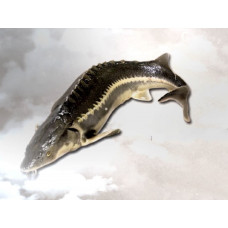Sturgeons (Acipenseridae) are a family of bony fish of the Acipenseriformes order. They are passable, semipassable, and freshwater fish distributed in the waters of the Northern Hemisphere. Their body is covered with five rows of large bony plates - bugs. The body is elongated, spindle-shaped, the snout is elongated or shovel-shaped. The mouth is located on the underside of the head, in the form of a transverse slit. In front of the mouth there are four antennae. Includes 4 genera: Huso huso, Acipenser, Scaphirhynchus and Pseudoscaphirhynchus. They grow slowly, live up to 50-100 years, and become sexually mature late (beluga at 12-18 years, sturgeon at 16-19 years, sterlet at 4-8 years). Spawning is not regular, intervals are 4-5 years and more. They reproduce in spring and summer in fresh water. Eggs are bottom, sticky. Form winter and spring races. Valuable commercial fish, the number of which is sharply declining. The hybrid bester is of important commercial importance.
Sturgeons are rather large fish (beluga reaches a length of 4 m). The body is elongated in length, almost shaft-shaped. The sturgeon family belongs to the cartilaginous ganoids subclass. The body has 5 longitudinal rows of bony flaps - beetles; the snout is elongate, almost spade-shaped or conical, with a small transverse toothless mouth, which lies on the lower part of the head and can extend; on the underside of the snout, in front of the mouth, 4 antennae arranged in a transverse row; vertical fins in front with a single row of fulcra (see Ganoides); dorsal fins in front with a single row of fulcra (see Ganoides). Ganoid); dorsal and anal fins close to caudal fins; gill membranes merge at the throat and are attached to the pharynx; gill rays absent; gills 4, there are also 2 adventitious gills; swim bladder large, simple, with communication with the dorsal side of the esophagus. Sturgeons are characterized by the development of müllerian ducts, as an exception among vertebrates. Sturgeons are long-lived fish, e.g. belugas live up to 100 years and reach sexual maturity at the age of 15-20 years.
All sturgeon fish are either passable or freshwater; passable fish, as well as those living in lakes, enter rivers to throw eggs. Sturgeon fish are prolific, and the number of eggs in large individuals is several million, but they can only throw eggs after reaching sexual maturity, which occurs at the age of 15-20 years in different species. In addition to spring migration into rivers for spawning, sturgeon fish also enter rivers in some places in the fall for wintering. These fish mainly stay near the bottom and feed on various animal food: fish, mollusks, worms, and insects.
In the river, sturgeon larvae feed first on zooplankton (daphnia, etc.), then the fry switch to crustaceans - mysids, gammarids, and sometimes to chironomids. Beluga juveniles still in the river switch to predatory feeding.
Sturgeons appeared about 245 to 208 million years ago around the end of the Triassic period, making them one of the oldest living ray-finned fishes. True sturgeons appear during the Upper Cretaceous period. During the same period, sturgeons reached a significant heyday, with giants like Acipenser gigantissimus appearing in the group with lengths of over 6 meters. During this time, sturgeons underwent only minor morphological changes, indicating that their evolution was exceptionally slow. This is partly due to their long generation interval, ability to tolerate wide ranges of water temperature and salinity, lack of predators due to size, and abundant prey base in benthic environments. Although their evolution has been remarkably slow, they are a highly evolved living fossil and do not closely resemble their ancestral forms. However, Sturgeons still have several primitive characteristics such as a heterocercal caudal fin, fewer scales on the body, more rays in the fins than supporting elements, and a hanging jaw.
Despite the availability of fossils, a complete classification and phylogeny of sturgeon species has been difficult to determine, particularly because of high individual and ontogenic variability, including geographic clines in certain traits such as shape, number of shields, and body length. Another hindering factor is the special ability of sturgeons to produce reproductively viable hybrids even between species belonging to different genera. While Actinopterygii have a long evolutionary history. Researchers in the past have identified more than 40 species that have been rejected by more recent studies. Whether species in the genera Acipenser and Huso are monophyletic (descended from a single ancestor) or paraphyletic (from many ancestors) is still unclear, although a morphologically motivated separation between the two genera is clearly not supported by genetic data. Efforts are underway to resolve the taxonomic confusion using ongoing synthesis of systematic data and molecular techniques. The phylogeny of sturgeon fishes in the cladogram indicates that they evolved from bony fishes.
Sturgeons
Tags: sturgeons



